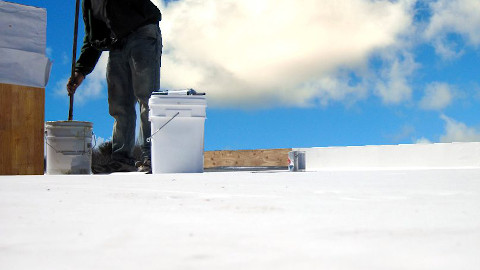
A study by the ICTA-UAB evaluates the effectiveness of different urban solutions to reduce the temperature in the Metropolitan Area of Barcelona. Combining the two strategies would have a temperature reduction of 1.26 degrees.
The frequency and intensity of heat waves in cities is increasing due to climate change, with a great negative impact on the health and mortality rates of the population. Anthropogenic activities and urban materials affect heat accumulation in cities, and solar radiation stored throughout the day on asphalt and buildings is released slowly during the night, generating significant heat stress. To face this growing problem, cities must establish effective mitigation strategies that allow reducing the temperature during heat waves.
A study carried out by researchers from the Institut de Ciència i Tecnologia Ambientals of the Universitat Autònoma de Barcelona (ICTA-UAB) assesses the effectiveness of solutions such as the creation of cool (white) roofs on the buildings and the expansion of urban green areas in the Barcelona Metropolitan Area (AMB). The results, recently published in the scientific journal Urban Climate, show that the combined application of these two strategies would allow achieving the highest rates of temperature reduction during these summer episodes.
To conduct the study, the researchers used a meteorological model that included eleven different typologies of urban areas in the AMB and simulated the heat wave recorded in July 2015, when daytime temperatures reached between 35ºC and 40ºC, and night temperatures exceeded 25ºC.
The study simulated different mitigation scenarios based on solutions such as the creation of cool roofs on residential and industrial buildings, or the increase of green areas according to the targets set by the Urban Master Plan (PDU) of the AMB. Cool rooftops can be obtained by painting the roofs white to increase the albedo, that is, the percentage of radiation that reflects from the surface, and that is not absorbed by the building. For its part, the PDU calls for the addition of 6 urban parks and green areas with a total of 255.64 ha by 2030, which means increasing the vegetation from 32.54% to 35.92%.
The four scenarios analysed the effects of increasing the albedo of certain rooftops to 0.85 by painting them white, preferably flat and accessible roofs; increase urban green areas with a daily irrigation of 2 l/m2, and with a higher irrigation of 5 l/m2. The last scenario combined the option of cool roofs with the creation of additional green areas with irrigation of 5 l/m2.
The results show that the scenario that combines the two strategies is the one with the greatest impact, with an average temperature reduction of 1.26 ºC. The reduction reaches 4.73ºC during the day (at 3pm), and 1.88ºC at night (9pm). This decrease in heat also has positive effects on energy consumption, with 26% less spending on air conditioning.
The first scenario with cool roofs allows the average temperature to be reduced by 0.67ºC, but is more effective during the day, reaching a maximum reduction of 3.83ºC at 3 pm, compared to the maximum decrease of 1.63 ºC at night (7h). The strategy of increasing the green areas reduces the temperature to a lesser extent, although it offers better results in the scenario with greater irrigation (decrease of 0.15ºC on average for irrigation of 2 l/m2, compared to a decrease of 0.61ºC in the scenario with irrigation of 5 l/m2). "We have seen that when irrigation is increased, the reduction in daytime temperature improves notably thanks to the cooling effect caused by evapotranspiration", says Joan Gilabert, lead author of the study.
Despite the reduction in temperature in all the scenarios studied, the thermal regulation resulting from the combination of the two strategies (white roofs and green areas) is the one with the greatest impact. "It combines the benefits of reducing the temperature at nighttime due to more urban green areas, with the reduction of daytime heat due to the increased albedo and irrigation, thereby abating the heat wave effects throughout a 24-hours period", explains Sergi Ventura, co-author of the study. He adds that white rooftops lower the temperatures in the central and denser urban areas, while parks help to reduce the heat in the areas closest to them.
This study exemplifies how such urban modelling efforts can aid city-level decision-makers in best strategizing urban planning to counteract the impacts of heat waves, which are foreseen to increase due to global climate change and the intensification of urbanization rates
Scientific article
Gilabert, J., Ventura, S., Martilli, A., et al. (2021). Abating heat waves in a coastal Mediterranean city: What can cool roofs and vegetation contribute? Urban Climate. https://doi.org/10.1016/j.uclim.2021.100863
This information is related to the following SDG
-
Good health and well-being
-
Sustainable cities and communities
-
Climate action






